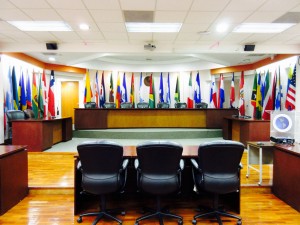 By Kaley Lachapelle
By Kaley Lachapelle
Because Canada is not a State Party to the American Convention on Human Rights (also referred to as the Pact of San Jose, Costa Rica), many Canadians are not familiar with the Inter-American System for the protection of human rights. Having returned to Canada just over a month ago, I have had the opportunity to discuss my experience at the Inter-American Court of Human Rights (hereinafter the Court) with a number of fellow law students, family and friends.
When describing the adjudicative body and function of the Inter-American System, I find that people are often surprised to learn that there are three parties to a dispute brought before the Court: the State, the alleged victims (or their representatives) and the Inter-American Commission of Human Rights (hereinafter the Commission) (Articles 23 – 25 of the Rules of Procedure of the Inter-American Court of Human Rights).

In accordance with Article 33 of the American Convention, compliance by states with the provisions of the Convention is ensured by two supervisory organs: the Commission and the Inter-American Court of Human Rights. Once domestic remedies have been exhausted, an alleged victim may lodge a petition against a State Party before the Commission (Articles 44 & 45 of the American Convention). The purpose of the Commission is to amicably reach a settlement between the parties (Article 48(f) of the American Convention). If, however, the State fails to implement the provisions of the settlement agreement and/or does not comply with the recommendations made by the Commission within the period prescribed, the Commission may submit the petition to the Court, in accordance with Articles 48 – 51 and 61 of the American Convention. States Parties may also submit a case before the Court. Alleged victims or their representatives, however, may not bring a claim before the Court; rather, a claim must be brought on their behalf by the Commission.
The procedure for bringing a case before the Court is desirable as it encourages parties to engage in a dialogue with one another in a conciliatory fashion with the purpose of reaching an out-of-court agreement. Only in cases where the State has not taken action to implement its commitments or the recommendations of the Commission will the adversarial dispute resolution organ of the Inter-American system be engaged.
So, to answer the question, ‘is three a crowd?’, I would say that no, it is not. Although some may argue that, in essence, the alleged victim is represented twice before the tribunal, by both its own counsel as well as by the Commission, it is important to note that the Commission does not always put forward the same arguments as the representatives. Furthermore, while there can be cost-efficiency arguments made in favour of a two-party dispute resolution mechanism, as having three parties to the dispute is inherently more costly and time-consuming, I would argue that the Commission is well placed to offer a balanced, informed position before the Inter-American Court and that, therefore, its presence is desirable.
My experience working at the Court this summer taught me that both the Court and the Commission play very important, yet distinct, roles in monitoring compliance with the human rights obligations of states.
